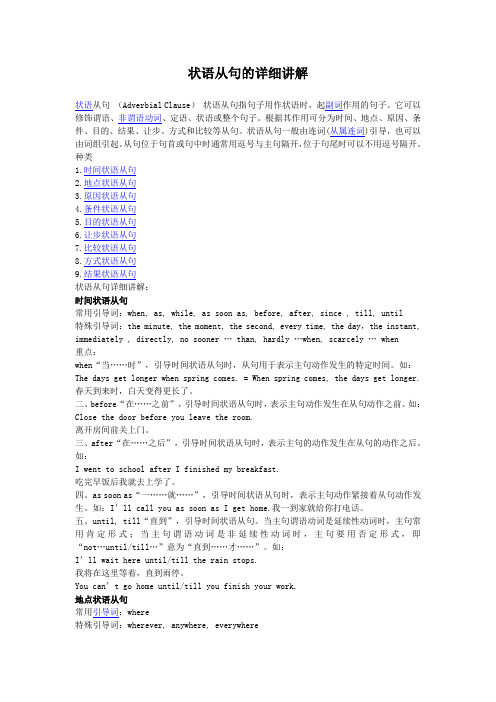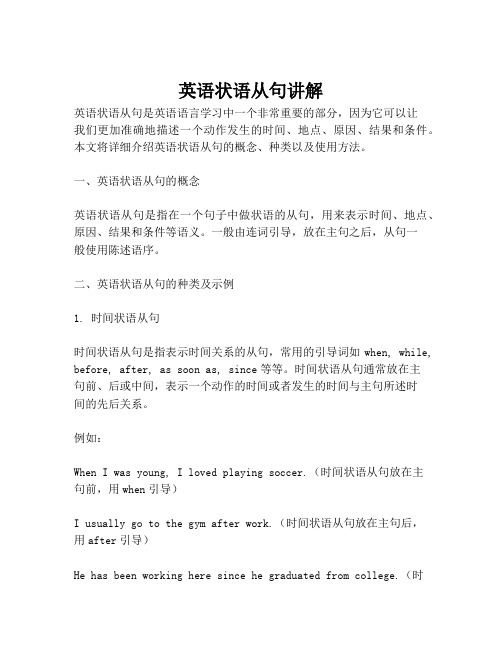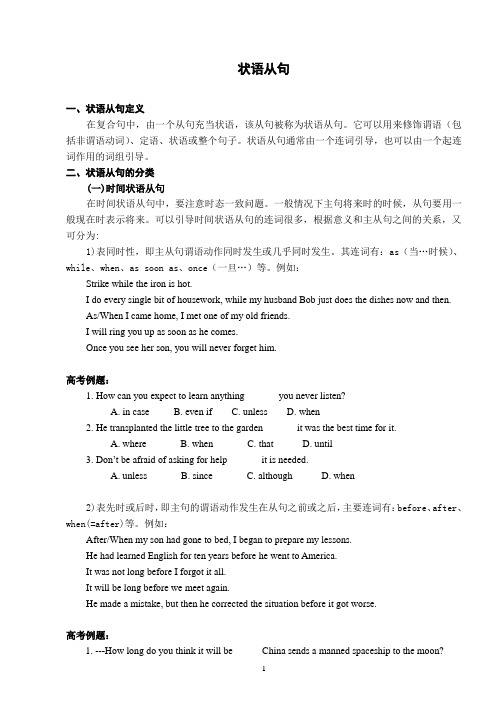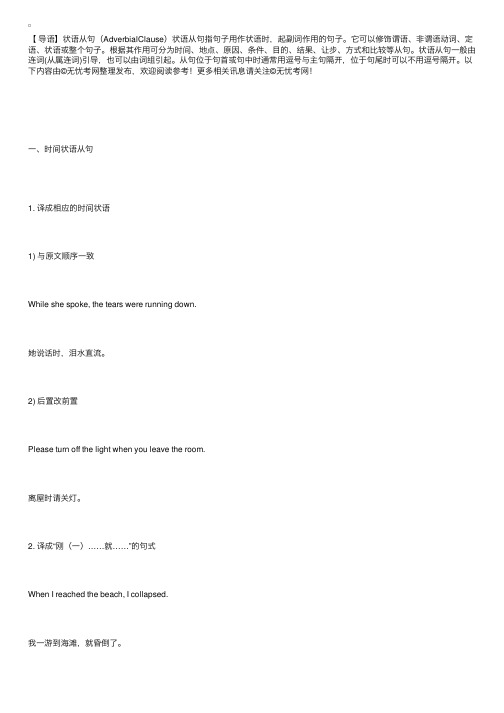状语从句讲解
(完整版)状语从句的讲解最全的状语从句讲解

状语从句的讲解就是用一句话作状语分为:时间,地点,方式,原因,结果,条件,让步,目的,比较一、时间状语从句第一次见到你一见到你我就喜欢上了你直到见到你五岁时见到你When, as, while, before, after, since, till/until, as soon as no sooner…than…scarcely…when…hardly…when… the minute the second the instant the moment by the time 截止 immediately instantly directlyeach time every time next time the first time on doing sthwhenwhile 当…时as1。
when 1)当…时/ 延续性动词短暂性动词都可用2)这时/3)届时、到时I was watching TV when my cellphone suddenly rang这时When I was five years old I could speak five languagesThe wet weather will continue tommorow when a cold front is expected to arrive届时到时注意:时间状语从句中动作发生有前后时先发生的用过去完成时When my mother came back I had already gone to bed.2。
while 1)从句动词延续性2)同时发生3)对比的意味“然而”4)趁着He taught himself while he worked in a bank 延续性动词当他在银行上班时While we were working they were having a rest.对比While they were having a discussion , they got very confused。
状语从句的详细讲解

状语从句的详细讲解状语从句(Adverbial Clause)状语从句指句子用作状语时,起副词作用的句子。
它可以修饰谓语、非谓语动词、定语、状语或整个句子。
根据其作用可分为时间、地点、原因、条件、目的、结果、让步、方式和比较等从句。
状语从句一般由连词(从属连词)引导,也可以由词组引起。
从句位于句首或句中时通常用逗号与主句隔开,位于句尾时可以不用逗号隔开。
种类1.时间状语从句2.地点状语从句3.原因状语从句4.条件状语从句5.目的状语从句6.让步状语从句7.比较状语从句8.方式状语从句9.结果状语从句状语从句详细讲解:时间状语从句常用引导词:when, as, while, as soon as, before, after, since , till, until特殊引导词:the minute, the moment, the second, every time, the day,the instant, immediately , directly, no sooner … than, hardly …when, scarcely … when重点:when“当……时”,引导时间状语从句时,从句用于表示主句动作发生的特定时间。
如:The days get longer when spring comes. = When spring comes, the days get longer. 春天到来时,白天变得更长了。
二、before“在……之前”,引导时间状语从句时,表示主句动作发生在从句动作之前。
如:Close the door before you leave the room.离开房间前关上门。
三、after“在……之后”,引导时间状语从句时,表示主句的动作发生在从句的动作之后。
如:I went to school after I finished my breakfast.吃完早饭后我就去上学了。
英语状语从句讲解

英语状语从句讲解英语状语从句是英语语言学习中一个非常重要的部分,因为它可以让我们更加准确地描述一个动作发生的时间、地点、原因、结果和条件。
本文将详细介绍英语状语从句的概念、种类以及使用方法。
一、英语状语从句的概念英语状语从句是指在一个句子中做状语的从句,用来表示时间、地点、原因、结果和条件等语义。
一般由连词引导,放在主句之后,从句一般使用陈述语序。
二、英语状语从句的种类及示例1. 时间状语从句时间状语从句是指表示时间关系的从句,常用的引导词如when, while, before, after, as soon as, since等等。
时间状语从句通常放在主句前、后或中间,表示一个动作的时间或者发生的时间与主句所述时间的先后关系。
例如:When I was young, I loved playing soccer.(时间状语从句放在主句前,用when引导)I usually go to the gym after work.(时间状语从句放在主句后,用after引导)He has been working here since he graduated from college.(时间状语从句放在主句后,用since引导)2. 地点状语从句地点状语从句表示一个动作所发生的地点,通常由where、wherever 引导。
例如:Wherever you go, I will follow you. (地点状语从句中,wherever 引导)I will go wherever the wind takes me.(地点状语从句中,where 引导)3. 原因状语从句原因状语从句表示主句的动作发生的原因,通常由because、since、as等引导。
例如:Since it was raining outside, I chose to stay at home.(原因状语从句中,since 引导)Because she was sick, she couldn't go to the party.(原因状语从句中,because 引导)4. 结果状语从句结果状语从句用于表示主句所述的情况或动作的结果,通常由so、such...that等引导。
状语从句讲解

不久我们就动身去北方了。 不久我们就动身去北方了。 It was not long before we left for the north. 再过一年你就毕业了。 再过一年你就毕业了。 It will be a year before you graduate. 用不了多久我们就会知道实验的结果了。 用不了多久我们就会知道实验的结果了。 It will not be long before we know the result of the experiment. 过了一段时间他们才意识到事情的真相。 过了一段时间他们才意识到事情的真相。 It was some time before they realized the truth.
I will tell her about it when I see her. I was about to fall asleep when my sister came in. I will go home when he comes back.
I recognized the thief when/ as I passed him. When he finished his lecture, people stood up and applauded. I was walking on the street when I came across an old friend. We were about to set off when it began to rain. He had just finished the work when the doorbell rang. We were on the point of driving away when the policeman signed us to stop.
英语状语从句讲解

状语从句一、状语从句定义在复合句中,由一个从句充当状语,该从句被称为状语从句。
它可以用来修饰谓语(包括非谓语动词)、定语、状语或整个句子。
状语从句通常由一个连词引导,也可以由一个起连词作用的词组引导。
二、状语从句的分类(一)时间状语从句在时间状语从句中,要注意时态一致问题。
一般情况下主句将来时的时候,从句要用一般现在时表示将来。
可以引导时间状语从句的连词很多,根据意义和主从句之间的关系,又可分为:1)表同时性,即主从句谓语动作同时发生或几乎同时发生。
其连词有:as(当…时候)、while、when、as soon as、once(一旦…)等。
例如:Strike while the iron is hot.I do every single bit of housework, while my husband Bob just does the dishes now and then.As/When I came home, I met one of my old friends.I will ring you up as soon as he comes.Once you see her son, you will never forget him.高考例题:1. How can you expect to learn anything ______ you never listen?A. in caseB. even ifC. unlessD. when2. He transplanted the little tree to the garden ______ it was the best time for it.A. whereB. whenC. thatD. until3. Don’t be afraid of asking for help ______ it is needed.A. unlessB. sinceC. althoughD. when2)表先时或后时,即主句的谓语动作发生在从句之前或之后,主要连词有:before、after、when(=after)等。
状语从句讲解

状语从句讲解状语从句由从属连词(subordinating conjunctions)引导。
注意状语从句与主句之间的逻辑关系,选择正确的连词;有些连词能引导多种状语从句。
一、时间状语从句引导时间状语从句的从属连词主要有:after,as,before,once, since,till,until,when,whenever,while,as soon as;另外有些词如:immediately(立刻),directly(直接的),instantly(立即地)用于as soon as 意义时,有些名词词组如the moment(片刻),the instant(立即的),the minute,the day,the year,every time,next time,each time 等也用来引导时间状语从句:The mother didn't go to bed until her little daughter returned home last night. 昨晚母亲等到她的小女儿回家才睡觉。
I'll explain it to you immediately I've finished reading the letter. 我读完信立刻给你解释。
You see the lightning __________it happens,but you hear the thunder later.A)the instant(立即) B)for an instantC)on the instant(马上) D)in an instant(马上)闪电一发生,你立刻就能看到它,但雷声,你迟一点才能听到它。
(B4,1997.1-38,A对。
)No sooner ... than 和hardly/scarcely/barely ... when 也用来引导状语从句,意思是“一……就……”;如果将no sooner,hardly, scarcely,barely放在句首,就用倒装结构。
英语语法:五类状语从句的翻译讲解

【导语】状语从句(AdverbialClause)状语从句指句⼦⽤作状语时,起副词作⽤的句⼦。
它可以修饰谓语、⾮谓语动词、定语、状语或整个句⼦。
根据其作⽤可分为时间、地点、原因、条件、⽬的、结果、让步、⽅式和⽐较等从句。
状语从句⼀般由连词(从属连词)引导,也可以由词组引起。
从句位于句⾸或句中时通常⽤逗号与主句隔开,位于句尾时可以不⽤逗号隔开。
以下内容由©⽆忧考⽹整理发布,欢迎阅读参考!更多相关讯息请关注©⽆忧考⽹!⼀、时间状语从句1. 译成相应的时间状语1) 与原⽂顺序⼀致While she spoke, the tears were running down.她说话时,泪⽔直流。
2) 后置改前置Please turn off the light when you leave the room.离屋时请关灯。
2. 译成“刚(⼀)……就……”的句式When I reached the beach, I collapsed.我⼀游到海滩,就昏倒了。
3. 译成并列的分句1) 译⽂前置They set him free when his ransom had not yet been paid.他还没有交赎⾦,他们就把他释放了。
2) 后置不变I was about to speak when Mr. Smith cut in.我正想讲,史密斯先⽣就插嘴了。
⼆、原因状语从句1. 译成表“因”的分句1) “因”在“果”之前The crops failed because the season was dry.因为⽓候⼲旱,作物歉收。
2) “果”在“因”之前She could get away with anything, because she looked such a baby.她能渡过任何风险,因为她看上去简直还像娃娃模样。
2. 译成因果偏正复句中的主句Pure iron is not used in industry because it is too soft.纯铁太软,所以不⽤在⼯业上。
状语从句讲解及习题附答案

状语从句讲解及习题附答案(一)状语从句概述定义状语从句用作状语,是起副词作用的句子。
位置状语从句可以放在主句之前,也可以放在主句之后,时间、条件、原因和让步状语从句放在句首时需要用逗号和主句隔开。
分类根据其作用可以分为时间、地点、原因、条件、目的、让步、方式和比较等状语从句。
作用它可以修饰谓语、非谓语动词、定语、状语和整个句子。
(二)状语从句详解1. 时间状语从句引导词用法示例when 意为“当…的时候”。
When引导从句的谓语动词可以是延续性动词,也可以是瞬间动词。
并且when有时表示“就在那时”A liar is not believed when he speaks the truth.说谎者讲真话时也没有人相信。
When he arrives, I’ll call you. When you laugh and smile, your body relaxes.while 意为“在…的时候,在…的同时”。
While引导从句的谓语动词必须是延续性的,发生时间较长,并强调主句和从句的动作同时发生(或者相对应)。
While有时还可以表示对比。
While I was standing at the window, I saw several boys running along the street.While John was watching TV, his wife was cooking.as 意为“一边…一边…”。
As引导的动作是延续性的,发生时间较短,一般用于主句和从句动作同时发生;as也可以强调一前一后。
The writer was angry as he was travelling on a train to London because someone had invaded his “space”.He smiled as he stood up.after 意为“在…之后”。
- 1、下载文档前请自行甄别文档内容的完整性,平台不提供额外的编辑、内容补充、找答案等附加服务。
- 2、"仅部分预览"的文档,不可在线预览部分如存在完整性等问题,可反馈申请退款(可完整预览的文档不适用该条件!)。
- 3、如文档侵犯您的权益,请联系客服反馈,我们会尽快为您处理(人工客服工作时间:9:00-18:30)。
状语从句专项练习 1. Don’t be afraid of asking for help___ it is needed. A. unless B. since C. although D. when 2. Someone called me up in the middle of the night, but he hung up ___ I could answer the telephone. A. as B. since C. until D. before
5. ___ today, he would get to Beijing in three days. A. If he was leaving B. Were he to leave C. If he leaves D. If he is leaving 6. ____ when the telephone rang. A. Hardly he had gone to sleep B. Hardly had he gone to sleep C. No sooner he had gone to sleep D. No sooner had he gone to sleep
3) even if / even though/ although/ though 都作“虽然”,“尽管”解释, 都作“虽然” 尽管”解释 尽管 但是even if 和 even though 所表示 但是 的让步语气最强, although次之 次之, 的让步语气最强 次之 though最弱。 最弱。 最弱
9) The parent birds will not go their separate ways until the young ____ birds leave the nest. 10) The pianist waited for silence ______ he began to play. before
The first time he went to Shanghai, he paid a visit to his former teacher. 他第一次去上海时去拜访了他的老师。 他第一次去上海时去拜访了他的老师。 The moment I saw him, I thought of his father. 一看到他就想起了他的父亲。 一看到他就想起了他的父亲。 我
Grammar exercises
在下面的空格处填入适当的连接词。 在下面的空格处填入适当的连接词。
1) I was persuaded to do the job, ______ though I didn’t want to. 2) I talked to Henry _____ the football while players were resting in the middle of the game.
外研版 高二 (5) Module 5
Adverbial Clause
1. 时间状语从句注意点 1) when/while/as 的用法 when表示从句和主句动作同时发生 表示从句和主句动作同时发生, 表示从句和主句动作同时发生 或先于主句动作;while表示从句的动 表示从句的动 或先于主句动作 作与主句动作同时发生,并且有延续 作与主句动作同时发生 并且有延续 的含义; 从句与主句动作相并发生 从句与主句动作相并发生, 的含义 as从句与主句动作相并发生 常译为“ 常译为“边……边……” 边
6) Hard __ the task is, he is determined as to finish it. 7) ________ she may have told you, I Although still think she is not to be trusted. 8) I will not buy it unless the price is fair. _____
3) The students listened carefully ______ they should fail to follow the in case speaker. 4) _________ she got anything to eat, Each time she would save it for her children. 5) They promised to wait until the clock ____ struck twelve.
He will never tell you the truth even if he knows it. 即使知道这个秘密他也不会告诉你。 即使知道这个秘密他也不会告诉你。 The old woman was unhappy though she has a lot of money. 这个老太太不快乐虽然她很有钱。 这个老太太不快乐虽然她很有钱。
我们刚走进大厅讲座就开始了。 我们刚走进大厅讲座就开始了。 这个孩子刚一走到门边就回来了。 这个孩子刚一走到门边就回来了。 Hardly had we walked into the hall when the lecture started. No sooner had the boy reached the door than he came back.
You will improve your oral English if you keep on practising. He will never make progress unless he works hard. 如果你坚持练习, 如果你坚持练习 你的英语口语将 会提高。 会提高。 如果不努力他将不会取得进步。 如果不努力他将不会取得进步。
3. 让步状语从句注意点 1) whatever (whenever, however…) 和no matter what( when, how…)这两种形式 这两种形式 都可以引导让步状语从句, 意义无差异。 都可以引导让步状语从句 意义无差异。 Whatever (=No matter what) happens, we will not change our mind. 无论发生什么, 我们都不会改变主意。 无论发生什么 我们都不会改变主意。
2. 条件状语从句注意点 1) if 和unless是最长用的条件从句连 是最长用的条件从句连 接词, 接词 unless在意义上等于 在意义上等于 ‘if…not’,并且语气较强。if 可用 并且语气较强。 并且语气较强 于虚拟条件句, 于虚拟条件句 unless 则一般不用 于虚拟条件句。 于虚拟条件句。
3. ___I know the money is safe, I shall not worry about it. A. Even though B. Unless C. As long as D. While 4. If we work with a strong will, we can overcome any difficulties, __ great it is. A. what B. how C. however D. whatever
They shouted slogans as they passed the square. 他们一边穿过广场一边呼喊口号。 他们一边穿过广场一边呼喊口号。
2) 含有关联词组 含有关联词组hardly…when和no 和 sooner…than的两种句子结构表示 的两种句子结构表示 “一……就……”。当hardly 或no 就 。 sooner为于句首时,要到装。 为于句首时,要到装。 为于句首时 Hardly had he arrived when it began to snow. 他刚到天就开始下雪了。 他刚到天就开始下雪了。
If I were you, I would give up smoking at once. 如果我是你我会立刻戒烟。 如果我是你我会立刻戒烟。
2) in case Please take your raincoat along with you in case it rains. 请带把雨伞以防下雨。 请带把雨伞以防下雨。
3) 一些表示时间的名词词组 如the 一些表示时间的名词词组, moment, each time, every time, the first time, the year 等, 也用于引导 时间状语从句, 时间状语从句 这是它们担当着连接 词的功能。 词的功能。 Each time he came, he would bring us a lot of flowers. 他每次来都给我们带很多花。 他每次来都给我们带很多花。
However difficult (=No matter how difficult ) the work is, we will try our best to finish it on time. 无论这项工作多难, 无论这项工作多难 我们都会尽力 按时完成。 按时完成。
2) 形容词 副词 名词 形容词/副词 名词+as/ though可引导 副词/名词 可引导 一个让步状语从句, 表示强调。 一个让步状语从句 表示强调。 她虽然年轻却很有生活经验。 她虽然年轻却很有生活经验。 虽然还是个孩子, 他却能说三种语言。 虽然还是个孩子 他却能说三种语言。 Young as/though she is, she knows so much about life. Child as/though he is, he can speaks three languages.
When I was walking down the street, I saw some policemen. While the child was playing with his toys, his parents were watching TV. 当我沿着街道走的时候看到一些警察。 当我沿着街道走的时候看到一些警察。 这个孩子玩玩具的时候他的父母在看电视。 这个孩子玩玩具的时候他的父母在看电视。
